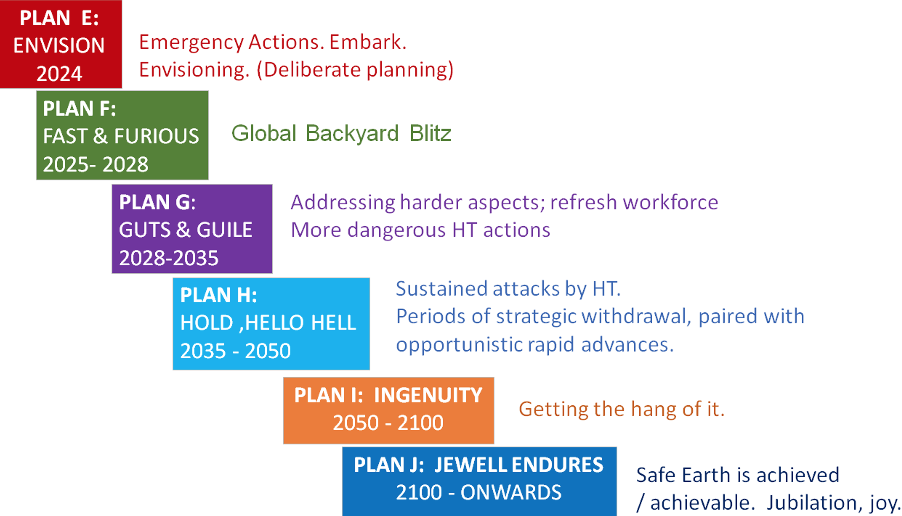Climate and ecological security: time for rogue thinking?
July 27, 2023
Imagine encountering an enemy and, as it starts to reveal its full array of tactics and capabilities, a feeling of ice-cold fear runs through your chest. In an instant, you realise that you are out-matched; youve been out-witted, and defeat is a real possibility. As has occurred so often in military history, the threat assessment was wrong. The problem-framing disguised the real nature of threat, and while you were blinded, it quietly grew in strength and seized vital terrain.
This is perhaps how much of humanity feel when they contemplate the hyperthreat of climate and environmental crisis, which has just launched three bold advances heatwaves in Earths air, sea, and ice domains. Scientists admit it is another sign that we don’t really understand the pace of change".
D-day for effective response was 1st January 2020. Unfortunately, instead of sprinting towards a low carbon future, humanity ran the other way. All forms of greenhouse gas emissions rapidly grew and more fossil fuel projects so-called carbon bombs were approved. In the US, the Biden administrations approval of fossil fuel projects outpaced even that of the Trump administration. Australia faced a similar outcome from its progressive government. Last week, the G20 failed to reach an agreement on cutting fossil fuels.
What this means is that the hyperthreats main body forces have not been contained and will arrive from 2030 onwards. No one is ready. Humanity is scattered, disorganised and lacks threat optics. Protestors, attempting to disrupt the hyperthreat are arrested. The hyperthreat had infiltrated humanitys governance, legal, finance and communication systems, and at times, its security forces. Billionaires revert to Plan B bunker building. The hyperthreat commander smiles, its vanguard operations have been highly successful in dismantling humanitys threat response capability. Humanity is flailing.
Meanwhile, the defence sector, charged with protecting their States, people and territories are focused elsewhere. Western nations frame the major security problem now as being a showdown between democratic versus autocratic forms of governance. Non-western nations see a looming contest to establish a multi-polar rather than a unipolar world.
For both, its a battle for power and dominance in the context of unraveling planetary, human and security. If you scratch away the ideological coatings, you could say what was being embarked upon was partly a race for whats left. Ironically, such warfare would strengthen the hyperthreat, while further delaying and distracting humanitys capacity to mount an effective hyper-response. Again, the hyperthreat grins. Never interrupt your enemy while they are making a mistake.
Perhaps by Hyperthreat design, climate security investigations were contained to the threat multiplier approach considering how to respond to a deteriorating world, not how to protect it. The result, the hyperthreat chuckles to itself, is that humanitys vast and expensive diaspora of intelligence agencies, think tanks and defence forces have been limited to producing what Warner and Boas described as mundane solutions that havent galvanised exceptional action.
Enter a renegade. A rebellious thinker part military, part climate, part theorist, with a sprinkle of eco-theology. Someone who belongs to no tribe. Who does not look like a military theorist at all. Someone who sees the hyperthreat for what it is and has been quietly planning a hyper-response.
The rebel took a different approach. Immediately, and breaking the first rule of climate-security discourse, she framed climate and environmental change not as an influence on the threat environment, (the standard threat multiplier or amplifier framing), but rather as the main threat. She perceived the hyperthreat as constituting a new form of violence; it was a Frankenstein like killing and destruction phenomenon, the likes of which humanity had never encountered before.
Rather than being a neutral hazard, the hyperthreat involved new forms of hostile intent to cause harm. Certain economic actors called Resource Eagles powerful multinational corporations controlling fossil fuels and other critical resources were brought into the threat analysis. No longer favoured clients of security strategy, they now faced scrutiny for their contribution to slow violence and ecocide. Ways to curtail this currently legal, dispersed form of killing would be considered in the strategic response.
Next, the hyperthreat was subjected to a modified military appreciation process. The result was PLAN E, a climate and environmentally centred grand strategy for security in the 21st century. It was published by the US Marine Corps University Press in 2022, in two parts (theoretical and demonstrational).
Shattering pre-climate approaches to security, directly challenging extant threat posture, and moreover, written by a female ex-military logistician not a combat corps warfighter(!) it was promptly sidelined by most climate security; climate policy; climate emergency response and even, ironically, the women, peace and security sectors. But the general population, and odd people of good will within the system showed interest.
What does PLAN E involve?
PLAN E is the first stage of a six-phase Hyper Response that extends to 2100 (see Figure 1).

The HyperResponse is a civil-led, civil mobilisation, (distinct from militarisation.) It rests on the establishment of a Planetary Emergency Peace Treaty and involves a new rules-based order orientated around ensuring foundational planetary security a habitable planet with new legal laws around ecocide, for example.
PLAN E sees a full year dedicated to supported, deliberate planning across all sectors of society, plus some emergency actions. It involves ongoing Hyper-Conversations and a project called Creative State where the state re-imagines its function and tasks in a planetary crisis.
Most importantly, being a security mission, HyperResponse has the capability to override the power of corporations and to enforce their adherence to new eco-survivability-based laws. Yet many steps are put in place to avoid a confrontational approach; all sectors and communities would be supported by Transition Teams to become valued actors in HyperResponse.
An initial priority is a rescue mission of humanitys most beloved Ally, (nature). Operation Beauty, expected to employ at least 20 million people, has the mission of protecting, restoring, and strengthening ecosystems.
PLAN E provides an example of what could be if the security mission was redefined to match the nature of the times.

